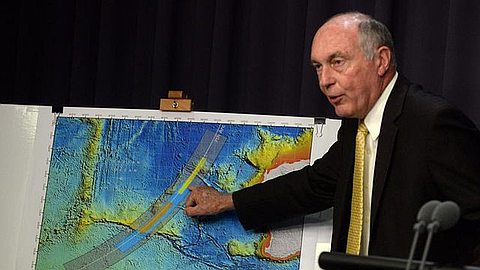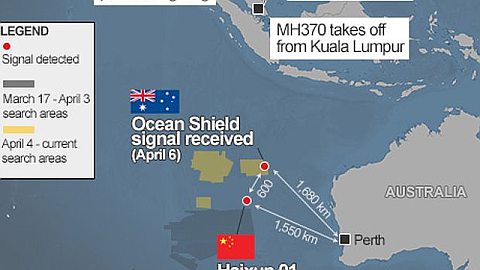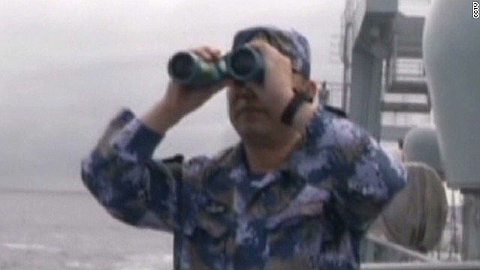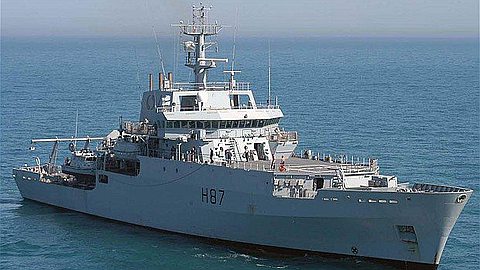New Speed Data Shifts Search for Missing Malaysian Jetliner Nearly 700 Miles
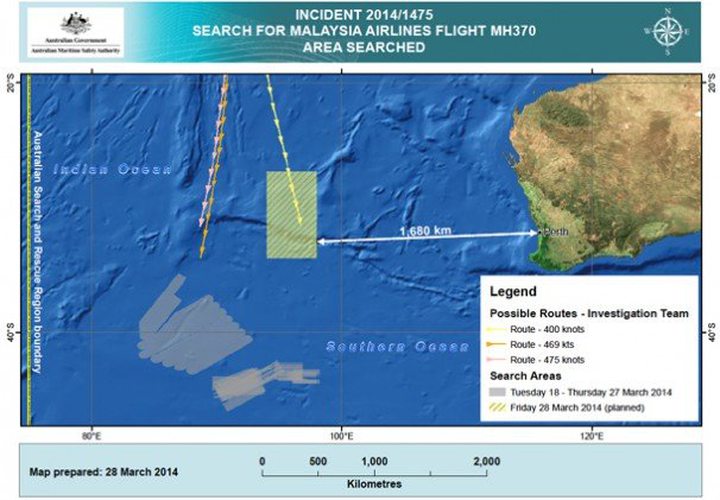
The new search area is 680 miles northeast of where planes and ships have been scouring the waters for signs of the aircraft. It is also massively larger: 198,200 square miles, compared to the 48,500 square mile patch of ocean where the search had been focused, according to the Australian Maritime Safety Authority.
The redirection of the search comes as a result of analysis of radar data collected as the plane traveled between the South China Sea and the Strait of Malacca, before contact was lost, AMSA said. Those data show that the aircraft traveled faster than investigators thought, burned its fuel more quickly, and therefore traveled a shorter distance, according to the Australians. Authorities said they believe this new section of the ocean includes the spot where the flight ended its bizarre March 8 journey. The plane, carrying 239 passengers and crew, was supposed to fly from Kuala Lumpur to Beijing, but abruptly turned around an hour into the journey and headed south with its various communications systems all off line, a sequence of events investigators must still unravel.
Friday’s development suggests that the phase of the search that began on March 18 in the southern Indian Ocean — and seemed to be steadily honing in on a smaller portion of the water — has been on the wrong track for more than a week. The new area, though, is much closer to Perth, which will give planes more time to search, said Australian officials. And it moves the operation away from the part of the ocean known as the “roaring forties,” where extreme weather has proven to be a major hurdle.
It is not clear how authorities are now regarding the objects spotted by satellites in recent days, floating in an area far to the southwest of the refocused search.
Malaysian defense minister Hishammuddin Hussein said that the objects seen in the satellite images are still potentially pieces of the missing plane or its cargo since ocean drift and the unpredictable currents in that part of the ocean could account for their location.
Australian officials said the new lead was based on continued analysis of information pieced together from radar and satellite data during the course of the investigation.
Martin Dolan, chief commissioner of the Australian Transport Safety Bureau, said on Friday that the decision to shift the search further north came from a closer analysis of the existing data, rather than from new information.
The Australian-led search has spent several days trying to track down debris detected by various satellites, which had offered the strongest leads until now in the hunt for the plane. But so far, observers on low-flying planes and on ships have come up empty handed.
On Monday, a Thai satellite spotted at least 300 floating objects in the southern Indian Ocean, where authorities say the plane went down almost three weeks ago, a Thai official said Thursday.
The images were taken by the Geo-Informatics and Space Technology Development Agency, a Thai space research agency, and show objects more than 1,600 miles southwest of Perth, Australia, said Anond Snidvongs, executive director of the agency.
“I wouldn’t say the debris is from the Malaysia Airlines flight,” Anond said by telephone from Bangkok, adding that analysts could not be certain. “We just spotted a lot of floating objects.”
He said the items were as small as 6 1/2 feet and as long as 52 1/2 feet. They were seen about 124 miles from where French satellites detected a group of more than 100 objects earlier in the week.
The ships and planes looking for the missing passenger jet immediately changed their routes on Friday to reflect the new analysis. As of early afternoon, four out of the 10 aircraft working on the search were in the updated region, and six more planes were expected to join them. One Chinese patrol ship was already there, with six more ships on the way. An Australian naval ship is due to arrive Saturday night.
Between bad weather and the unpredictable interplay of wind and ocean currents, observers have run into a series of dead ends.
Wednesday’s search area, for example, included the location where a French satellite detected signs of 122 objects. Observers saw three items in the area late in the day: two that were likely rope plus a blue object. When planes flew overhead again to take a look, they could not spot them.
The search team is racing to identify a likely crash site so that the operation can focus next on finding the all-important black box containing cockpit audio and flight data. U.S. Navy equipment that can listen for “pings” from the black box has arrived in Perth, according to Australian officials. An Australian navy support vessel that can tow the pinger locator underwater is supposed to arrive within days. The black box will emit signals for 30 days, meaning there is a little more than a week left to find it before it goes silent. The depth of the water in the new area is between 1.2 miles and 2.5 miles, Australian officials said.
Australian authorities described on Friday trying to piece together a puzzle using different sources of data: from radar, satellite, and what manufacturers know about the plane’s performance, among other factors.
“There are a range of scenarios that had to be fed in, and that’s one of the reasons why the search area remains a very large one,” said Dolan. “And this is something that we probably should underline … This is still an attempt to search a very large area and for surface debris, which will give us an indication of where the main aircraft wreckage is likely to be. This has a long way to go.”
